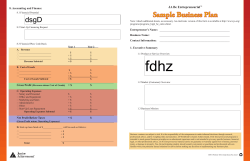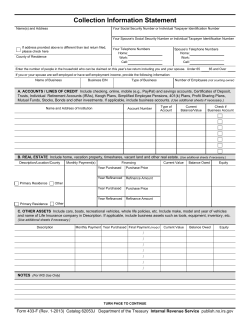
A Bright Idea
A Bright Idea Do you have an entrepreneurial spirit? Do you dream of being your own boss? Many people have the desire and some solid ideas for starting a new business, but they either lack the courage to take the first step or they don’t know where to start. Here is some information that may help guide you in taking those first steps. Develop a Business Plan • This is the blueprint of your operations for the next couple of years. You control the level of detail, but it should cover: * The type of business, product, or service offered * Types of customers * Pricing * Start-up capital * Forecasting of revenue and expenses * Marketing plans • For help, consult sources at the public library, over-the-counter computer software, the Chamber of Commerce, local colleges, and websites like that of the Small Business Administration at www.sba.gov. • A business plan is important for obtaining a business loan to set up operations. Registration of Business • From a tax standpoint, you need to decide whether you’re going to embark on this endeavor alone, as a sole proprietor, or with others, as a partnership. * You may also want to consider incorporating. • Depending on which you choose, you may have to deal with legal ramifications. * Some states allow you to just start a business. * Other states require you to register the type of business and follow certain guidelines before you are able to open the doors. Location of Business • The location could be crucial, depending on the business type. • Parking, space, and cost are all important considerations. Tax Considerations • Most businesses need an employer identification number (EIN). This number is the equivalent of the Social Security number for a business. * You can obtain a federal EIN by filing Form SS-4, Application for Employer Identification Number. * Form SS-4 is available from your tax preparer, the IRS, or the Social Security Administration. * You can mail, fax, or submit by tele-TIN your Form SS-4 to the IRS service center for your area. • You’ll need to include this number on all employee payroll reports. • Even if it does not have any employees, any entity other than a sole proprietorship must have an EIN to file income tax returns. • Additionally, your state will probably require a state identification and/or sales tax number for the same reasons. Employees • If you plan to have employees, you are generally responsible for: * Payroll taxes * Social Security taxes * Medicare taxes * Unemployment taxes * Collection of federal and state (where applicable) withholdings * Employee’s share of Social Security and Medicare taxes • As an employer, you are responsible for making deposits of the collected taxes at the appropriate times throughout the year. • Unless you qualify as a small employer who files Form 944 annually, file Form 941 quarterly to inform the government of the withholdings and payments. • The IRS will require you to annually file Form 940 for unemployment tax information. • Failure to file and pay on a timely basis could result in severe penalties. • Some employers avoid the payroll cycle by treating individuals as independent contractors. * The IRS has issued a set of criteria it uses to determine whether an individual is an employee or an independent contractor. * If you incorrectly treat an employee as an independent contractor, you may be subject to penalties. * Before you make this determination, discuss it with your tax advisor. • You may also need to make estimated tax payments for the business entity. • The sole proprietor would be responsible for income tax and self-employment tax on the business profits. Record Keeping • It is important to establish a good record keeping system early in your business. • It is necessary to keep an accurate account of the following: * Payroll records * All income and expenses related to the business • Most businesses have the option of choosing the cash method, the accrual method, or a hybrid method of accounting. • If the IRS were to audit your return, you may have to prove expenses by producing receipts. Start-up Costs • You may need to separate some expenses. The two categories are: 1) Expenses you incur in exploring and setting up the business. You may deduct $10,000 of start-up costs for tax years beginning in 2010 (and $5,000 for tax years beginning in 2011). The remaining expenditures are amortized over 180 months, beginning in the first year your business begins. 2) Expenses you incur from the time the business officially begins. These are currently deductible. • Start-up expenses may include training wages, pre-opening utilities, rent, advertising, depreciation, and any exploration costs. Capital Expenditures Not all of the expenses paid for a business are currently deductible. • Items that have a life of more than one year are currently depreciated or amortized rather than deducted. • Equipment and real estate are common examples of depreciable assets. • If your business requires you to maintain an inventory of the items you sell or use to make a product, these costs become part of inventory that you will deduct as you sell the product. • It is necessary to keep accurate records of the beginning and ending inventory each year. Starting a Business Other Considerations • Liability and asset protection. • Fringe benefits desired (if any). • State and local requirements, such as licenses, permits, and registration of the business. CAROL THOMAS TAX PREPARATION 14015 Van Ness Ave., Suite 20 Gardena, CA 90249 (310) 295-2215 – Office (310) 295-2279 – Fax www.cttaxprep.com Enrolled Agent ~ Notary Public Tax Problem Specialist This brochure contains general tax information for taxpayers. As each tax situation may be different, do not rely upon this information as your sole source of authority. Please seek professional advice for all tax situations. #843 – © Copyright December 2010 National Association of Tax Professionals PO Box 8002 Appleton, WI 54912-8002 www.natptax.com
© Copyright 2025





















